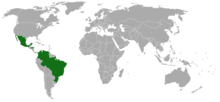Mimosa tenuiflora
| Mimosa tenuiflora | |
|---|---|
 |
|
 |
|
| Mimosa tenuiflora | |
| Scientific classification | |
| Kingdom: | Plantae |
| (unranked): | Angiosperms |
| (unranked): | Eudicots |
| (unranked): | Rosids |
| Order: | Fabales |
| Family: | Fabaceae |
| Subfamily: | Mimosoideae |
| Genus: | Mimosa |
| Species: | M. tenuiflora |
| Binomial name | |
|
Mimosa tenuiflora (Willd.) Poir. |
|
 |
|
| Range of Mimosa tenuiflora | |
| Synonyms | |
Mimosa tenuiflora, syn. Mimosa hostilis (Jurema Preta, Calumbi (Brazil), Tepezcohuite (México), Carbonal, Cabrera ) is a perennial tree or shrub native to the northeastern region of Brazil (Paraíba, Rio Grande do Norte, Ceará, Pernambuco, Bahia) and found as far north as southern Mexico (Oaxaca and coast of Chiapas), and the following countries: El Salvador, Honduras, Panama, Colombia and Venezuela. It is most often found in lower altitudes, but it can be found as high as 1,000 m (3,300 ft).
The fern-like branches have leaves that are Mimosa like, finely pinnate, growing to 5 cm (2.0 in) long. Each compound leaf contains 15–33 pairs of bright green leaflets 5–6 mm (0.20–0.24 in) long. The tree itself grows up to 8 m (26 ft) tall and it can reach 4–5 m (13–16 ft) tall in less than 5 years. The white, fragrant flowers occur in loosely cylindrical spikes 4–8 long. In the Northern Hemisphere it blossoms and produces fruit from November to June or July. In the Southern Hemisphere it blooms primarily from September to January. The fruit is brittle and averages 2.5–5 cm (0.98–1.97 in) long. Each pod contains 4–6 seeds that are oval, flat, light brown and 3–4 mm (0.12–0.16 in) in diameter. There are about 145 seeds/1 g (0.035 oz). In the Southern Hemisphere, the fruit ripens from February to April.
The tree's bark is dark brown to gray. It splits lengthwise and the inside is reddish brown.
The tree's wood is dark reddish brown with a yellow center. It is very dense, durable and strong, having a density of about 1.11 g/cm³.
...
Wikipedia
